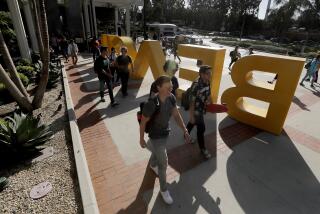Students Given a Lesson in Wildlife Survival and Governor’s Budget Cuts
- Share via
The 27 students from Paul Anderson’s biology class at Gompers Secondary School met the real world of applied biology last week in Ollie Ryder, geneticist at the San Diego Zoo.
By the time the sessions with Ryder were completed, the class had not only gotten a comprehensive overview of how biologists can use genetics to breed endangered animal species but also an understanding of why the issue of species survival should concern everyone, scientist and non-scientist alike.
Under sponsorship of the city school’s gifted and talented education (GATE) program, the seminar at the zoo introduced the attentive high-school seniors to conservation biology, an important and rapidly growing field in which endangered animals and plants are identified and rescue plans are devised to protect them and their environment.
The seminar was the zoo’s first on the subject for high school students. But because of proposed budget cuts by Gov. George Deukmejian, the first could well be the last. Deukmejian has submitted a 1987-88 budget that calls for elimination of state aid to programs for gifted students, a move that would slash $600,000 from the San Diego Unified School District’s $3.2-million annual GATE budget.
A proposal from school district administrators to trim an additional $400,000 in local funds from GATE was turned back by the school board last week. But the 40% cut still looming for the program probably means that outside seminars, such as the new zoo program, will be substantially curtailed, if not ended completely.
For all involved with the program, the loss of such enrichment programs--21 are planned during this school year, in a variety of subjects--would be significant.
“We can already see (reductions) in such programs and I’m glad I’m graduating this year,” said senior Rachelle Seelinger. She had just finished listening to zoo keeper Mike Bates explain how he bases the daily routine of caring for highly endangered red rough lemurs from Madagascar on principles of genetically based breeding that Ryder and others have researched.
“What’s so good about something like this is that we get to see how you really apply things,” she said. “You usually read about evolution and genetics in general terms, but here you really see how it is applied.
“And we’re the people who will have to do such research in the years to come. We are the people who have to learn about this now.”
Ryder, a specialist in the worldwide program to reintroduce the Przewalksi’s horse to its native Mongolian habitat, expressed gratification at the response of the students, especially at their rapt attention during his detailed explanation of genetic application to captive breeding. He included chromosomal studies, introgression, genetic load and other concepts difficult to understand but vital to successful conservation.
“I worked real hard in putting together the presentation and it all becomes worthwhile when you get the response,” Ryder said.
In his talks, the geneticist stressed that the rapid disappearance of tropical rain forests and other habitats harboring numerous species represents a severe threat to the planet’s future biological diversity. He noted that species elimination occurs not just in South America or in Africa, but in the backyard canyons and coastal sage of San Diego County as well, where development takes precedence over conservation.
Ryder pointed out to students that more than 800 species of mammals alone already have been identified as candidates for breeding intervention by zoos and contrasted that sobering fact with the less than 40 breeding programs now being funded by zoos cooperating worldwide.
The protection of animals and ecosystems “is a societal issue and requires citizen participation, not just the word of scientists saying what is right and what is wrong,” Ryder said. For that reason, Ryder said, he is irritated that his new seminar may be a victim of budget cuts.
Gompers teacher Paul Anderson already has plans for the students to follow up on the seminar by “adopting” a species and working up a theoretical process, using the genetic concepts they have learned, to breed and conserve it. Anderson might have the students “adopt” an ecosystem as well.
“These seminars always have the stigma of elitism attached to them,” Anderson said, “which I think is wrong. There is nothing wrong with making these students think.”
Pat Sumi, an educational consultant who sets up the outside seminars for the school district, said that, through the program, teachers meet experts in many fields who often are asked to speak to other classes, ones not labeled as gifted or advanced.
“GATE affects a lot of kids” in addition to those officially identified as such, Sumi said.
As to the future, she said, “I just don’t know what we will do.”
The entire outside seminar program costs $10,000, but it also depends on transportation and other associated budgets that also are expected to be trimmed in next year’s school district budget. The district is $10.5 million short of the funds it needs to continue current programs at the same level for the 1987-88 school year.
Hearings on the many proposed cuts continue at 3:30 p.m. today at district headquarters, 4100 Normal St.
More to Read
Sign up for Essential California
The most important California stories and recommendations in your inbox every morning.
You may occasionally receive promotional content from the Los Angeles Times.










